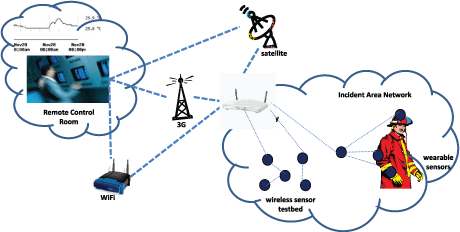by Socrates Varakliotis, Peter Kirstein and Steve Hailes
Telecommunications and information exchange are vital to the operation of emergency response units. The objective of the U-2010 project team is to use existing or future telecommunication infrastructure to provide the most capable means of communication and the most effective access to information to all the parties required to act in case of accident, incident, catastrophe or crisis. We are feeding our experiences with the technology involved in this area into the discussion on the future Internet.
Internetworking of Small Devices - The Internet of Things
Emergency response teams are increasingly being equipped with communication devices. To be of use to first responders, these devices must be light, versatile and autonomous, but also miniaturized, capable of sensing the environment, of tracing and tracking resources, and able to convey this wealth of information to civil protection authorities and crisis management centres. To put it simply, Wireless Sensor Networks (WSNs) have already gained momentum in public safety applications. Our approach requires that the devices for public safety be mobile (wearable, portable) and that the communication of their data to remote management teams be done in any possible way (always available). The scenario also envisages the use of autonomous subsystems like robots or Unmanned Aerial Vehicles (UAVs) that are IP-enabled.
To enable communication between small devices involved in such missions and to orchestrate effectively the flow of information made available by these devices, we advocate the use of IPv6 as the interconnecting protocol. The multitude of addresses required and its capabilities for node auto-configuration are two of the reasons for the deployment of IPv6 in such scenarios; the improvements in mobility and power usage made in IPv6 protocols over IPv4 for this environment are other important considerations. We also propose the use of light, multipurpose gateways, which interconnect small local clouds of WSNs and temporarily cache measurements for as long as necessary until a communication path to the mission control team is established.
Work done in the area of gateways builds upon some of the developments carried over from the EC-funded RUNES (Reconfigurable Ubiquitous Networked Embedded Systems) project. Here, open-source, small form-factor gateways supporting multiple network technologies such as Ethernet, Wi-Fi and IEEE 802.15.4 are being enhanced with protocol stacks suitable for wireless sensor Internetworking and basic multimedia capabilities. For example, a prototype gateway has been extended by the 6LoWPAN (IPv6 over Low power Wireless Personal Area Networks) adaptation layer and by the implementation of a lightweight video-streaming service with support for commodity USB cameras.
Infrastructure: Sensor Network Testbeds
The research approach we adopted is helped by the design, deployment and management of large distributed IPv6-based sensor network testbeds. Much of the work is experimentally trialled on the UCL Heterogeneous Experimental Network (HEN), a large research network deployment including devices ranging in size from low-power sensor nodes to server-grade multi-processor rack systems. We adapt the HEN infrastructure to design and run experiments with large numbers of network nodes, including HENs customizable sensor testbed comprised of over fifty motes spanning a fairly large lab area with realistic radio channel conditions. We scale such experiments to hundreds of motes and allow integration with external administrative and user planes, such as development offerings by Arch Rock, or entirely proprietary vendors such as Cisco, and other open-source operating systems, routers and WSN applications.
A number of other projects use HEN for some form of validation, such as work on novel MAC algorithms, for which the ease of creating dense networks with sensor nodes is invaluable.

WSN Mobility
The mobility requirements of first-response teams are studied in the context of network mobility. Ìost generic wireless sensor application scenarios assume the sensor nodes are static (wired or wireless). In novel applications, such as emergency response teams using communications equipment and sensor networks, the nodes need be nomadic, ie, nodes that move along with a response team. In networking terms, this translates to mobility paradigms such as NEMO (Network Mobility). Furthermore, in these studies more complex network routes emerge that are best approached by MANEMO solutions (Mobile Ad-Hoc Network Mobility). We are currently investigating both these forms of mobility in WSNs with external partners. We are also investigating what is required in nomadic nodes like robots and UAVs.
In this context, Transport Layer Multipath is currently being investigated as a possible future research area. Enabling a transport layer protocol to create a number of sockets (with distinct paths) and hide them behind what appears to applications as a single socket allows a number of novel interactions. These include raising throughput by load balancing between the sockets, improving reliability through the redundancy provided by multiple paths, and providing a mechanism for mobility by adding and removing paths. In this application, the normal concern of scalability with small numbers of points of failure is less important than in the general case.
Multipath to the sensors could be deployed through multiple paths to multiple gateways to the WSNs, for example. In the context of emergency services, the additional reliability gained by using multiple available backhaul connections (satellite and 3G) could be essential, while having simple mobility without the requirement for a home agent may also be advantageous. In addition, the potential for the aggregation of bandwidth between different access media could make it possible to offer services requiring high throughput, such as efficiently streaming high-quality video from an emergency site.
Links:
http://u2010.eu
http://www.ist-runes.org
http://hen.cs.ucl.ac.uk
Please contact:
Peter Kirstein
UCL Computer Science, UK
Tel: +44 20 7679.7286
E-mail: P.Kirstein![]() cs.ucl.ac.uk
cs.ucl.ac.uk










